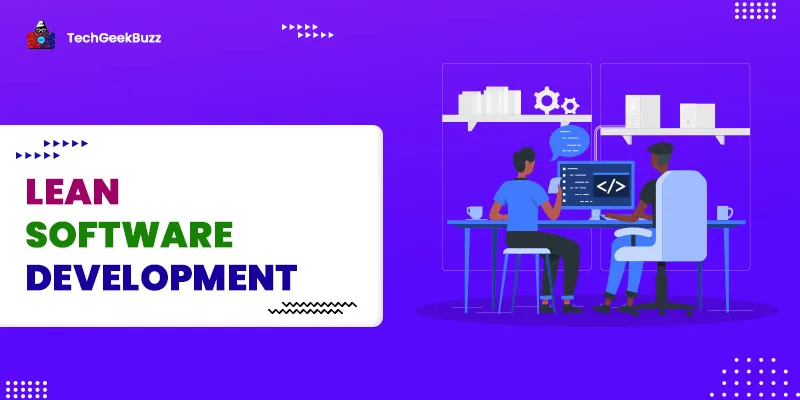The manufacturing sector is where the lean technique first emerged. However, today, it is employed in software development and many other domains, such as management and UX. Many software development companies are adopting this methodology to build and oversee software projects.
In the context of software development, the primary concept of this methodology is to optimize and streamline the entire development process while significantly reducing waste. As this methodology emphasizes reducing waste in the development process, Lean projects prove to be more effective and accelerate the time-to-market.
Lean methodology, commonly known as Lean Software Development (LSD), is a significant aspect of an agile methodology . It implies implementing lean principles in software development to reduce a software product’s time to market.
In this blog post, we shall walk you through lean software development (LSD), its principles, pros, and cons.
What is Learn Software Development (LSD)?
It is an agile framework that emphasizes the optimization of the software development process by eliminating waste and delivering only what the software product actually needs. It reduces programming effort, defect rates, and cost in the software development process .
Moreover, LSD is considered a Minimum Viable Product (MVP) strategy. This is because the development team releases a bare-minimum version of the product to end users. After its release, the development team focuses on what users like, what not, and what additional features they wish to have in the product. Based on customer feedback, they develop the final product.
As this methodology hails from the manufacturing industry, the term ‘lean’ there is perceived as the process of removing waste, i.e., less human effort, less time, less space, and less equipment. In service industries, like software development, waste could refer to manual and inefficient processes, repetitive tasks, tasks that do not provide any value, and technology sprawl.
In short, LSD is a strategy of removing everything that is useless or unnecessary, and that does not provide any value to the end product.
History of LSD
Until the 1990s, the concept of lean was not introduced to the world. Toyota first introduced the term lean in the Toyota Production System, which was developed by Taiichi Ohno and Eiji Toyoda, two Japanese engineers. They invented the lean approach to streamline their production of cars and eliminate the waste of time and resources in the production process.
Here, the company referred to waste as any activity that did not impact or enhance the functionality of the car under production. Therefore, they removed that activity from the production process.
After the inception of the lean process, many manufacturing industries started adopting it. In 2003, this methodology was first implemented in software creation. Meanwhile, Tom And Mary Poppendieck published the book named Lean Software Development.
Principles of Learn Software Development (LSD)
In the manufacturing industry, this methodology emphasizes reducing 7 wastes in the manufacturing process. These wastes are as follows:
- Waiting time
- Overproduction
- Processing
- Transportation
- Inventory
- Motion
- Scrap

The manufacturing concepts of LSD can be employed in software development by following seven major principles. These principles target eliminating waste and possible risks while delivering the software product within less time. They entail a set of practices, processes, and techniques that collectively contribute to the delivery of high-quality software products.
Let us now discuss the principles of LSD in detail below.
1. Eliminating the Waste
Project managers regularly conduct meetings after each development iteration to make a plan to eliminate all possible waste from the development process. This waste can be unnecessary code, inefficient and unclear communication, data duplication, delay in the activities involved in the development process, more tasks in the queue than completed ones, quality issues, etc.
Also, in such meetings, team members get an opportunity to highlight defects or issues in the software product and suggest effective solutions or changes.
2. Fast Delivery
Those days are gone when the key to success in business was long-time planning. However, over the ages, it came to light that such long-time planning results in the development of products that incorporate unnecessary features.
This issue resulted in the development of the Minimum Viable Product (MVP) strategy, which emphasizes releasing a minimal version of a product, i.e., with little functionality, to customers. Doing this helps the development team to identify what customers are actually looking for in the product. Depending on customers’ feedback, they start developing a product that meets their needs.
3. Amplify Learning
The most significant component of every job is learning. Similarly, in software development, learning plays a vital role. This can be facilitated by sharing knowledge among team members. And this takes place through code reviews and meetings. Often, software development employs pair programming to amplify learning, where two programmers work together to write and review computer programs.
4. Builds Quality
Ultimately, LSD is all about delivering software products quickly by eliminating waste without compromising quality. It entails releasing software products in their minimal version for customer feedback and analyzing it to create a strategy for developing high-quality products.
In short, we can say that this strategy is like the first failing and learning from the failure. Customer feedback significantly assists in elevating the quality of software products. Many times, the development team employs test-driven development to ensure the quality of software products.
5. Respect Teamwork
Respect among team members is a primary pillar for a collaborative, productive, and perfect working environment. And such an environment is crucial when there is a lot of workload and short deadlines. Instead of managing team members, the LSD method focuses on empowering and motivating people. It promotes proactive communication, healthy conflict, and constant feedback.
6. Delay the Commitment
Many times, in the conventional software development approaches, it happens when the development team builds an entire product and later realizes that it is completely unfit for the market. This results in a great loss.
This is not the case with the LSD approach. Fortunately, it provides room for improvements in software products by deploying irreversible decisions or changes. It facilitates the flexible development of software products so that any new feature or knowledge can be accommodated.
7. Optimizing the Whole System
The LSD approach promoted optimizing the development team’s performance by dividing an issue into smaller chunks and assigning them to different members. Doing this improves the team’s workflow, stimulates an essence of shared responsibility, and creates unity among team members.
Benefits of Lean Software Development (LSD)
The following are some remarkable benefits of LSD:
- Collaboration: From the above principles, we can interpret that LSD primarily focuses on amplifying learning, respecting and encouraging team members, and sharing knowledge among the team members. It creates an environment where team members can put their ideas forward and work together in the decision-making process.
- Continuous Improvement: The lean workflow entails constant communication with customers, accepting feedback, and improving software products based on feedback. This creates room for continuous improvement or Kaizen .
- Efficiency: It is an efficient approach because it focuses on eliminating waste and makes the delivery of software products quick. The elimination of waste also results in reduced costs.
- Quality: As lean facilitates continuous improvement, collaboration, flexibility, and efficiency, software products turn out to be of high quality and ensure maximum customer satisfaction.
- Flexibility: Continuous improvement through constant communication with customers and receiving their feedback creates a flexible environment.
- Reduced Costs: As LSD leverages the MVP strategy, it prioritizes incorporating essential features, eliminating the risk of investing time and money in developing useless software builds .
Challenges of Lean Software Development (LSD)
Though lean is an effective and efficient software development approach, it comes with a few challenges or pitfalls. Let us shed light on those challenges below.
- Requires Team Training: Team training is essential in LSD because if the team is not able to communicate and collaborate with each other, the result will not be satisfactory. They need the training to work collectively, adapt to new changes, and take over each other’s tasks. It is important for them to be capable of adjusting to changes in priorities and organizing themselves accordingly.
- Missing Metrics: The team members should be able to identify waste that has to be eliminated accurately. In doing so, there should not be a case where they miss an important metric to be eliminated or consider an important metric for elimination.
- No Boundaries: As lean software development promotes changes in requirements, the Software Requirements Specification keeps evolving. A lot of changing requirements can sometimes create chaos, which, in turn, can affect the final product.
- Suboptimization: It can create a problem because it involves splitting an issue into small parts and solving them individually without considering the effect of one part on other parts or on the whole system.
Conclusion
In the modern days, most organizations are adopting lean software development (LSD) as it is an effective approach to software development. It entails eliminating activities that do not provide any value to the final product. Doing this, in turn, reduces significant development costs and effort. However, the requirement for this approach is to have a skilled team in which members are open to sharing knowledge and adapting to new changes.
People are also reading:




